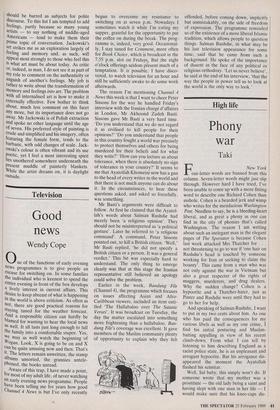Exhibitions
Joan Miro: Paintings and Drawings 1929-1941 (Whitechapel Art Gallery, till 23 April) Andrzej Jackowski (Marlborough Fine Art, till 10 March)
Morose Miros
Giles Auty
here is an irritating belief embedded
T
somewhere in the depths of the surrealist subsconscious which says th4t the most rewarding insights will forever escape our rational minds. In short, true wisdom can be found only through the medium of irrationality. The doctrine is a convenient one and explains why many avant-garde artists become so tiresome when drunk or when in a mood to pour hot coals on the mundane levels of thinking of ordinary people. Surrealism could claim to be the most influential of all 20th-century art movements and we are called on continual- ly by protagonists of modern art to pros- trate ourselves before its guard of honour: Joan Miro's 'Flame in Space and Nude Woman', 1932, at the Whitechapel Arp, Dali, Echaurren, Ernst, Lam, Mag- ritte, Masson, Matta, Tanguy et al.
Many other artists felt the tug of the surrealist vortex, notably such seminal figures of modern art as Giacometti, Picas- so and Pollock, yet a number of surreal- ism's central tenets have always struck me as questionable in the extreme. The move- ment's arch apologist, Andre Breton, was the co-inventor of 'automatic writing', an essentially poetic stream-of-consciousness stratagem which was claimed to lead to writing of a much more revelatory nature than any rational prose. Belief in the significance of this technique prompted Breton to his definition of surrealism: `Surrealism rests on a belief in the superior reality of certain forms of association hitherto neglected, in the omnipotence of the dream, in the disinterested play of thought. It tends definitely to destroy all other psychic mechanisms and to substitute itself for them in the solution of the principal problems of life.' All good, heady stuff, I am sure, and you may well wonder why it was that surrealism became, at one time, the official art form of communist parties in the West. Was it surrealism's gross irrationality which appealed? Three weeks ago I did my best to watch a film on television about the newly de- ceased Salvador Dali. This began, unprom- isingly for me, with the extraordinary and unsubstantiated claim that Dali was, with- out question, 'the most famous modern artist of this century'. Depressed by this inanity, I was next assailed by the sight of the old huckster hurling assorted liquids from a giant, simulated eggshell. I could not stomach more but do not doubt that Dali's death will prompt a rash of similar adulatory programmes. For our further education meanwhile, there is a large show at the Whitechapel of paintings and draw- ings by another Spanish surrealist: Joan Miro. The works date from 1929-41, period of personal crisis which led the artist to say: 'For my part I don't know where we're going. The only thing I know for sure is that I intend to destroy everything that exists in painting. Painting disgusts me profoundly.' You may gather that any previous good humour one associates with paintings by Miro, such as 'The Harle- quin's Festival', 1924-25, had taken a long holiday. The Whitechapel Miros are most- ly morose in mood, although peopled still by many of the familiar Miro portfolio of symbols: amoebae, balloons, eyes, arrows, insects, jellyfish etc, all linked by charac- teristic thread-like lines. Most of Miro's images float, anchorless, in tinted spaces often created by rubbing thinned colour into sheets of paper. While enjoying Miro's sculpture, I must confess a limited love for his linear images, which lack the lyrical range and refinement found in comparable works by Paul Klee. Further, Miro's 'Com- position (Head)', 1930, introduces to art the kind of informal ugliness which has become increasingly evident in the works of others during the past three decades. Miro can be reassured that his avowed aim to kill painting may even have borne some fruit.
The paintings of Andrzej Jackowski at Marlborough Fine Art (6 Albemarle Street, W1) are less about dreams, perhaps, than myth and archetype. Some time ago I proposed that dreams, together with possessions and personal surgery, should be barred as subjects for polite discourse. To this list I am tempted to add feelings, partly because so many young artists — to say nothing of middle-aged Americans — tend to make them their Prime topic of conversation. Jackowski's art strikes me as an exploration largely of feeling and memory and, as such, will appeal most strongly to those who feel this Is what art must be about today. As critic or, indeed, as man, I do not see it as part of my role to comment on the authenticity or anguish of another's feelings. My job is rather to write about the transformation of memory and feelings into art. The problem with all internalised art is how to make it externally effective. Few bother to think about, much less comment on this facet any more, but its importance does not go away. Mr Jackowski is of Polish extraction and spoke no other language until the age of seven. His preferred style of painting is Crude and simplified and his imagery, often featuring the female form, tends to the barbaric, with odd changes of scale. Jack- owski's colour is often vibrant and its use poetic, yet I feel a most interesting spirit lies smothered somewhere underneath the present muddle of painterly blankets. While the artist dreams on, it is daylight outside.

















































 Previous page
Previous page